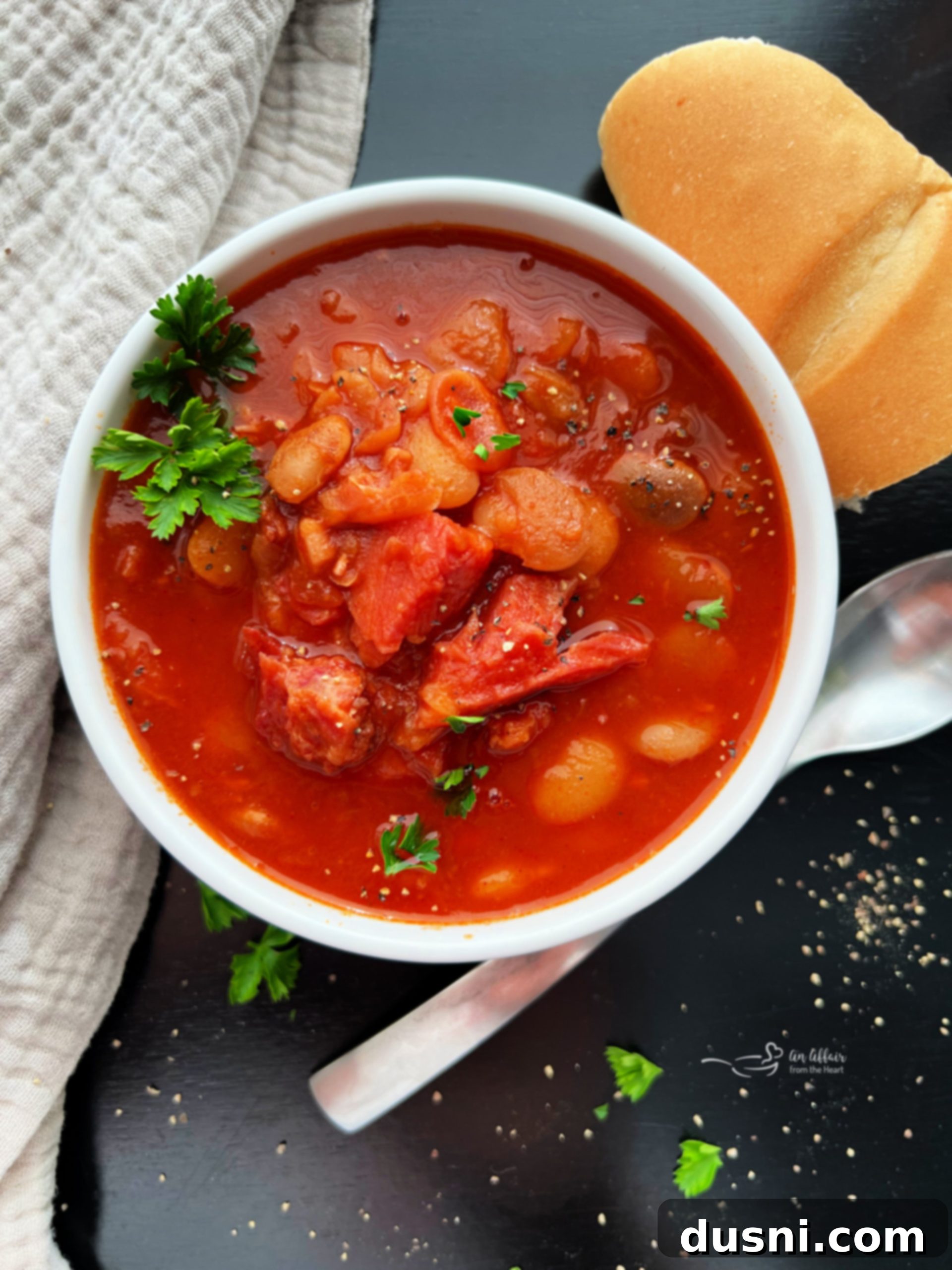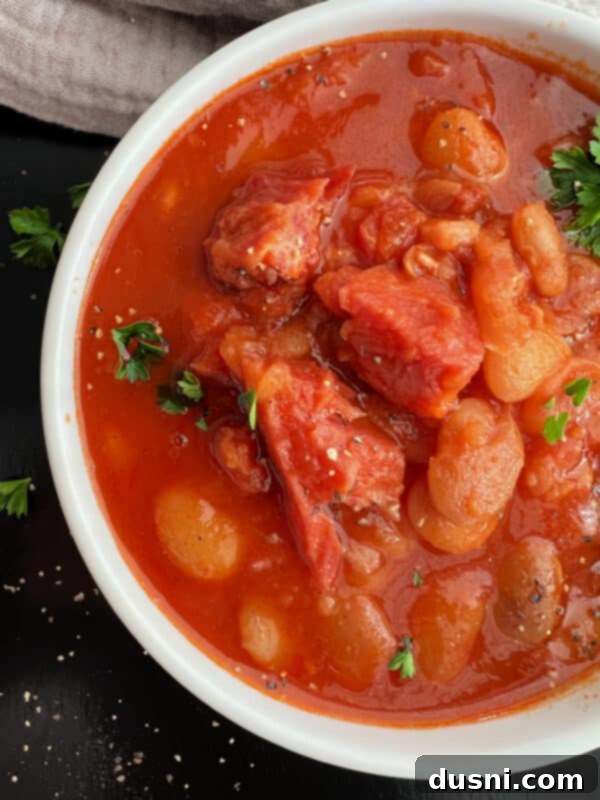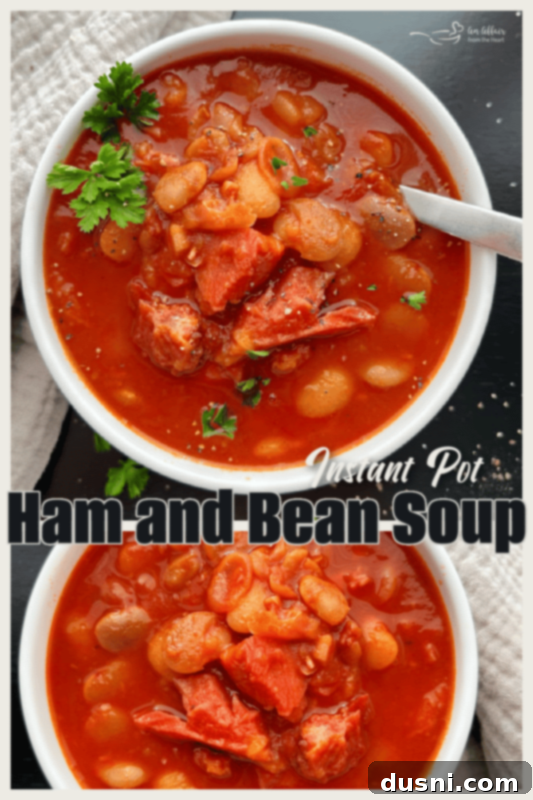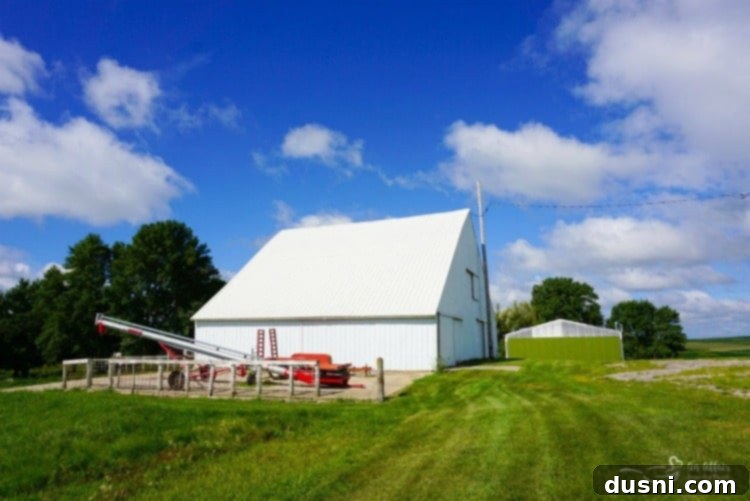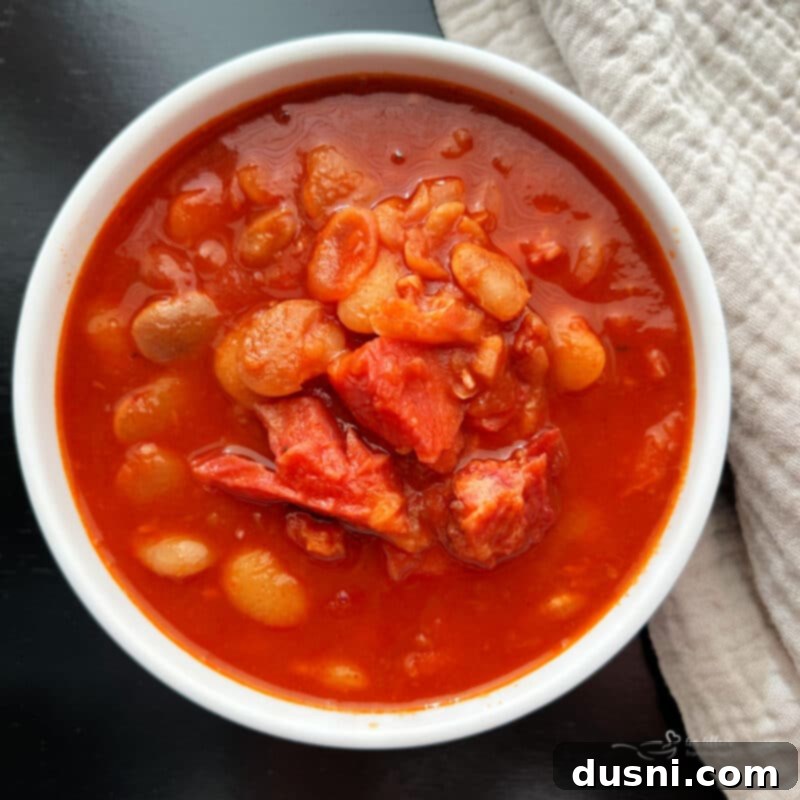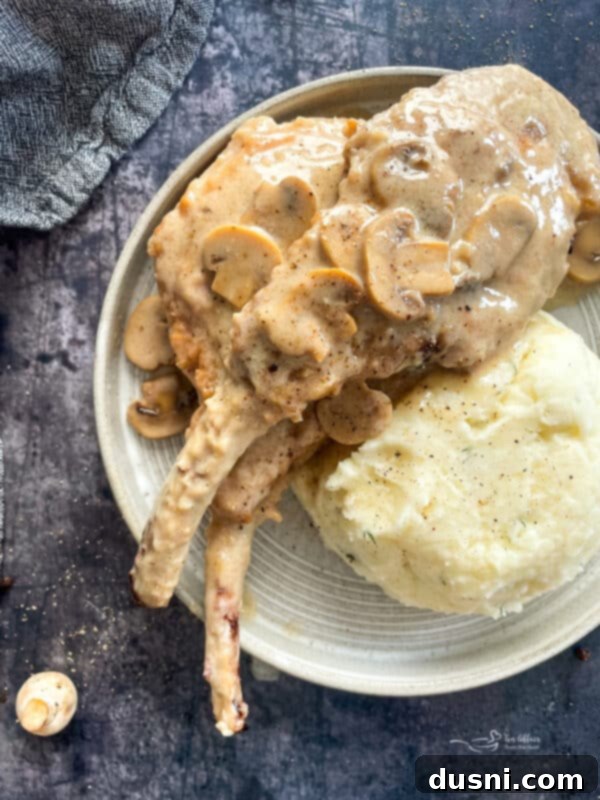Hearty Instant Pot Ham and Bean Soup: A Comforting Family Favorite Made Easy
This simple yet incredibly satisfying recipe for ham and bean soup comes together effortlessly in your pressure cooker, delivering a wholesome and deeply nourishing meal. Imagine a thick, rich tomato broth brimming with savory ham and tender lima beans – a combination that tastes utterly delicious, especially when the weather turns cold. This Instant Pot Ham and Bean Soup is not just a recipe; it’s a must-make tradition for soup season, bringing warmth and comfort to your table.

For as long as I can remember, Christmas Eve at our house has been marked by a treasured family tradition. My mom meticulously prepares a magnificent bone-in spiral-cut ham, serving as the centerpiece of our festive feast. What I cherish most about these holiday traditions is the comforting predictability – knowing precisely what delicious dishes await us each year. Alongside that glorious ham, you’ll always find our beloved Broccoli, Rice & Cheese Casserole, the irresistible Hashbrown Potato Casserole, sweet corn, and fluffy dinner rolls. It’s a meal that speaks of home, family, and timeless memories.
The magic doesn’t end there, though. The following week, after the holiday hustle subsides, my mom embarks on another culinary tradition: transforming the leftover ham bone into this incredible Ham & Bean Soup. She uses her trusty old-style pressure cooker, the very same one that has been a staple in her kitchen my entire life. There’s something inherently special about cooking with tools that carry a history of family meals.
This remarkable soup recipe, a true heirloom, originated with my grandma, her mother. Grandma affectionately called it “Lima Bean Soup,” but in our family, my mom has always referred to it as “Ham and Bean Soup.” This flavorful, hearty recipe is the ultimate way to serve your entire family a warm, comforting bowl of soup. It’s perfect for a quick weeknight dinner when you need something nourishing or a satisfying weekend lunch. The best part? It tastes even better the next day, assuming you’re fortunate enough to have any leftovers!
This post is proudly sponsored by Iowa Pork. All opinions expressed here, and my deep appreciation for Iowa Pork, are entirely my own.
SOME OF THE ITEMS BELOW CONTAIN AFFILIATE LINKS; I AM A PARTICIPANT IN THE AMAZON SERVICES LLC ASSOCIATES PROGRAM, AN AFFILIATE ADVERTISING PROGRAM DESIGNED TO PROVIDE A MEANS FOR US TO EARN FEES BY LINKING TO AMAZON.COM AND AFFILIATED SITES. I AM ALSO AN AFFILIATE FOR OTHER BRANDS. HOWEVER, I ONLY PROMOTE THINGS THAT I LOVE AND THINK YOU WILL LOVE, TOO. FOR MY ENTIRE DISCLOSURE POLICY PLEASE CLICK HERE.
Grandma’s Unique Ham and Bean Soup with a Rich Tomato Broth
One of the first things people notice, including my husband, when they try this ham and bean soup for the first time is its distinctive color. Typically, many ham and bean soup recipes tend to be lighter, almost white, in hue – I know that’s how my husband’s mother always prepared hers. However, our cherished family recipe stands out for a very simple, yet impactful, reason.
Instead of relying on plain stock or water for the broth, our family recipe has always incorporated rich, vibrant tomato juice. This isn’t just a minor substitution; it’s the secret ingredient that intensifies the flavor profile of the soup, adding a delicious depth and a slight tanginess that perfectly complements the savory ham and earthy beans. It transforms the soup from ordinary to extraordinary, creating a uniquely flavorful and visually appealing dish that truly sets it apart. The tomato broth provides a wonderful counterpoint to the saltiness of the ham, creating a perfectly balanced and incredibly comforting bowl of soup that you’ll crave again and again.
Making the Most of Leftover Ham: Delicious and Economical Recipes
In today’s world, where grocery costs seem to be ever-increasing, I’m committed to helping my readers make their food budgets go further. This year, my pledge is to demonstrate how to stretch your dollar and your meals by showcasing creative options to take one initial meal and transform its components into countless other delicious dishes. My Grandma’s Ham and Bean Soup is an exemplary illustration of this philosophy in action.
My grandma, a culinary wizard, embodied the principle of never wasting food. Her cooking was legendary, and this soup is a testament to her ingenuity. It beautifully demonstrates how a humble ham bone, salvaged from a previously cooked ham, when combined with a few readily available pantry staples, can yield a warm, comforting, and remarkably flavorful meal. It’s not just about saving money; it’s about honoring ingredients and creating something truly special from what might otherwise be discarded. This approach makes your meals more sustainable and incredibly satisfying.
Beyond this fantastic soup, there are numerous other delightful ways to utilize leftover ham. Here are a few more family favorites to inspire your kitchen creativity:
- Hawaiian Ham Balls: A delightful blend of sweet and savory, these ham balls are glazed with a tangy pineapple sauce, making them perfect as an appetizer or a main course.
- Smoked Ham & Gouda Quiche: Elevate your brunch or light dinner with this sophisticated quiche, featuring the smoky richness of ham paired with creamy gouda cheese in a flaky crust.
- Chicken Cordon Bleu Casserole: While traditionally made with fresh ham, leftover ham can be easily substituted here to add a delicious, savory element to this creamy, satisfying casserole.

Understanding the Nuances: Smoked vs. Cured Hams
It’s quite common for some home cooks to confuse smoked hams with cured hams, and to make matters even more intricate, the market also offers “fresh” hams, as well as hams that are both “smoked and cured.” To demystify this, let’s break down the distinctions, as understanding the type of ham you’re working with is crucial for both preparing your initial holiday feast and making delicious leftover meals like this ham and bean soup.
A **cured ham** refers to pork that has been preserved using a brine solution, which typically contains salt, sugar, and nitrites. This curing process enhances flavor, extends shelf life, and often gives the ham its characteristic pink color. Cured hams can come in either a cooked or uncooked state, so it’s vital to check the label carefully. A **smoked ham** is one that has undergone a smoking process, imparting a rich, distinctive smoky flavor. Smoking can be done on both cured and uncured hams, and it also contributes to preservation.
On the other hand, **fresh ham** denotes a specific cut of pork – the back top thigh of the leg – that has not undergone any curing or smoking process. Essentially, it’s raw, unprocessed pork. If you purchase a fresh ham, it must be both cured (if desired) and fully cooked before consumption. You’ll typically only find fresh ham by specifically requesting it from a butcher. Most hams found in the meat department of your local grocery store are usually pre-cooked, cured, and often smoked as well, and are clearly labeled as “ready to eat” or requiring further cooking. Always read the packaging to confirm the ham’s state before preparing it. This knowledge ensures both food safety and the best possible flavor for your dishes, whether it’s the main holiday ham or the bone used for your delicious Instant Pot Ham and Bean Soup.
The stunning photos you see accompanying this article are of a magnificent Double Smoked Ham with a Homemade Honey Glaze. This particular ham was prepared on my Traeger grill, which has become our absolute favorite method for preparing ham at home, yielding incredibly tender and flavorful results every time.
Ensuring Food Safety: Internal Cooking Temperature of Ham
You might wonder if the internal cooking temperature of ham, especially if it’s already smoked or pre-cooked, truly matters when you’re reheating or incorporating it into a dish like our ham and bean soup. The answer is a definitive yes, for food safety reasons. Even if a ham has been previously cooked or smoked, it’s crucial to ensure that when you prepare it at home, the internal temperature of the ham reaches a safe 140 degrees Fahrenheit (approximately 60 degrees Celsius). This is easily verified with a reliable meat thermometer inserted into the thickest part of the ham, avoiding the bone.
For comprehensive and precise cooking times and temperatures for all cuts of pork, including fresh, cured, and smoked options, the Iowa Pork Producers Association offers an invaluable resource. Their website is a fantastic guide for ensuring perfectly cooked and safe pork every time. I highly recommend bookmarking their handy guide to pork cooking temperatures; it’s an excellent reference tool for any home cook looking to confidently prepare pork dishes. Proper temperature ensures not only safety but also optimal texture and flavor.
How To Tell if Ham & Bean Soup is Done Perfectly
When preparing this delicious Instant Pot Ham and Bean Soup, there’s no need to guess about the doneness of your ham. The beauty of using a leftover ham bone is that the ham itself is already cooked prior to being added to the Instant Pot. The cooking process within the pressure cooker primarily serves to extract all that incredible flavor from the ham bone and infuse it into the broth, while also tenderizing the beans to perfection.
The soup reaches its ideal state of doneness when two key indicators are met: first, the ham should effortlessly fall from the bone, making it easy to remove and shred into the soup. This signifies that all the savory goodness has been released. Second, and equally important, the beans should be wonderfully tender and creamy, yet still hold their shape. They shouldn’t be overly mushy unless that’s your preferred consistency. Once these two conditions are satisfied, your comforting and flavorful ham and bean soup is ready to be enjoyed!
Essential Ingredients for This Hearty Ham and Bean Soup Recipe
You’ll find the complete list of ingredients with precise measurements and detailed instructions in the printable recipe card conveniently located at the very bottom of this post.

- Hambone – The star of the show! I typically use one ham bone with some delicious bits of ham still clinging to it, which adds immense flavor and texture to the soup. If you don’t have a whole ham bone, you can also use smoked ham hocks or ham shanks. For an even meatier soup, feel free to chop up some additional cooked ham from the grocery store (or more of your leftover ham) and toss it in at the end.
- Tomato Juice – This is our family’s secret ingredient that sets this soup apart! I use a full quart of tomato juice, which provides the rich, distinctive broth and a delightful tanginess that balances the savory ham.
- Onion – Half a medium onion, finely chopped, creates the aromatic foundation for our soup. Any common cooking onion, such as yellow or white, will work beautifully to build a deep, savory base.
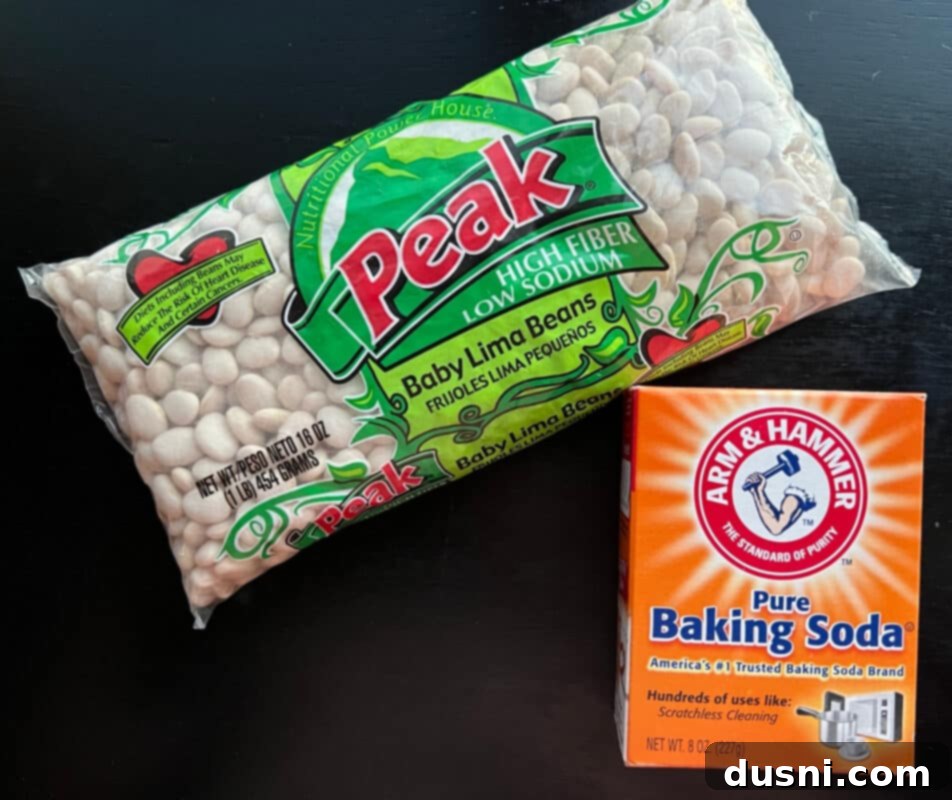
- Lima Beans – I use one standard package of dried lima beans. Their creamy texture and mild flavor are perfect for soaking up the rich tomato broth.
- Baking Soda – A small amount of baking soda is added during the bean soaking process. This not only helps to significantly reduce the potential for digestive discomfort often associated with beans but also aids in speeding up their cooking time, ensuring they become wonderfully tender.
- Water – Simple tap water is all that’s needed for the initial soaking of the lima beans, a crucial step for optimal texture and quicker cooking.
- Black Pepper – Freshly ground black pepper is my seasoning of choice for this soup, adding a subtle warmth and spice that enhances the overall flavor. While white pepper can be used, be aware it might impart a slightly different, perhaps smokier, flavor profile. We typically don’t add salt, as the ham provides plenty of salinity.
Step-by-Step: How To Make This Delicious Ham and Bean Soup
This recipe is celebrated for its quick and easy preparation, effectively utilizing a ham bone and a minimal list of economical ingredients to create a deeply satisfying meal. The Instant Pot truly shines here, making a traditional, slow-cooked soup achievable in a fraction of the time.

**The night before (or at least 8 hours prior):** Begin by thoroughly rinsing your dried lima beans under cool running water. Transfer the rinsed beans to a shallow baking dish or a large bowl. Evenly sprinkle them with baking soda, then cover them generously with cold water. Allow the beans to soak overnight, or for a minimum of 8 hours. This crucial step helps tenderize the beans and reduce cooking time, as well as making them easier to digest. Once soaking is complete, discard the soaking water.

After discarding the soaking water, give the lima beans another good rinse under cool, fresh water. This ensures any remaining baking soda is washed away and prepares them for cooking.
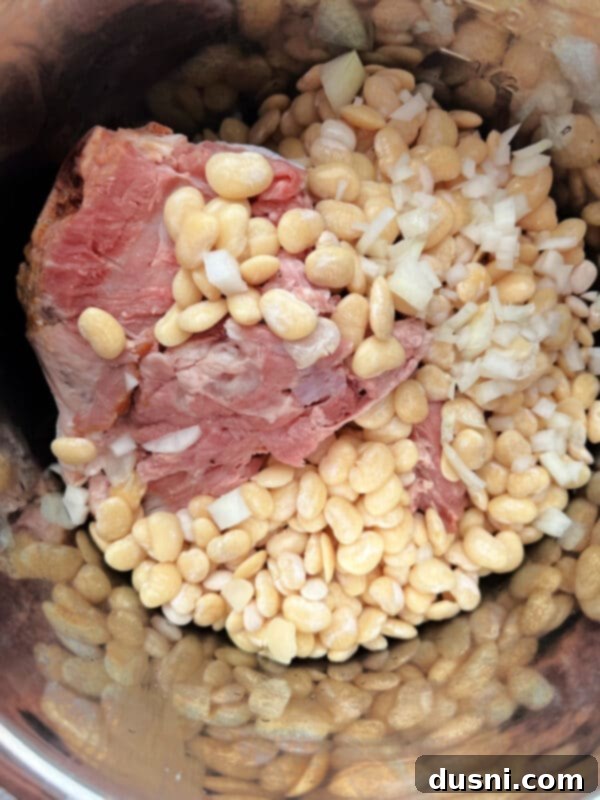
Now, carefully place your ham bone (with any delicious leftover ham still attached) into the inner pot of your pressure cooker.
**Tip:** If you plan on making this soup, remember to leave a good amount of ham on the bone when you originally carve your holiday ham. This extra meat will cook down beautifully into the soup. Alternatively, if your bone is bare, you can dice up some fresh or leftover cooked ham to add to the soup before it cooks for more meaty chunks.
Next, add in your thoroughly rinsed, soaked beans, the quart of rich tomato juice, and the chopped onion. Finish by sprinkling a generous amount of freshly ground black pepper over the ingredients.
**Note:** My mom, following Grandma’s tradition, often uses about two-thirds of the soaked beans in her recipe, which amounts to roughly 3 cups. I tend to follow suit, as I prefer a slightly more broth-heavy soup, and the beans do absorb a significant amount of the liquid as they cook. If you enjoy a thicker, heartier soup with less broth, feel free to use all of the soaked beans. Importantly, both my mom and I never add extra salt to this recipe, as the ham typically provides more than enough salinity to perfectly season the entire dish. Taste and adjust if necessary after cooking.
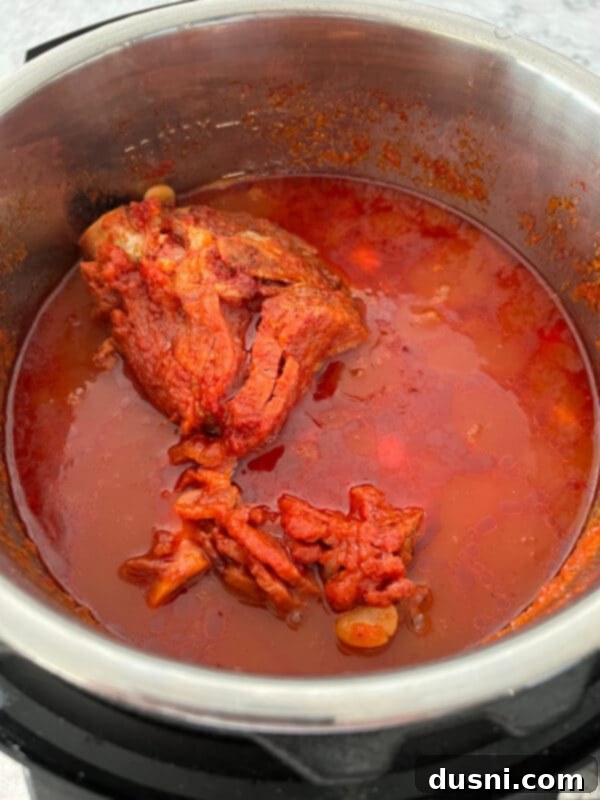
Secure the lid on your Instant Pot, ensuring the vent is sealed. Set your Instant Pot to the “Manual” or “Pressure Cook” setting for 25 minutes on high pressure. Once the cooking cycle is complete, allow the Instant Pot to perform a natural pressure release for 10 minutes. This slow release helps prevent the beans from bursting and helps meld the flavors. After 10 minutes, carefully manually release any remaining pressure by turning the venting knob before safely removing the lid.
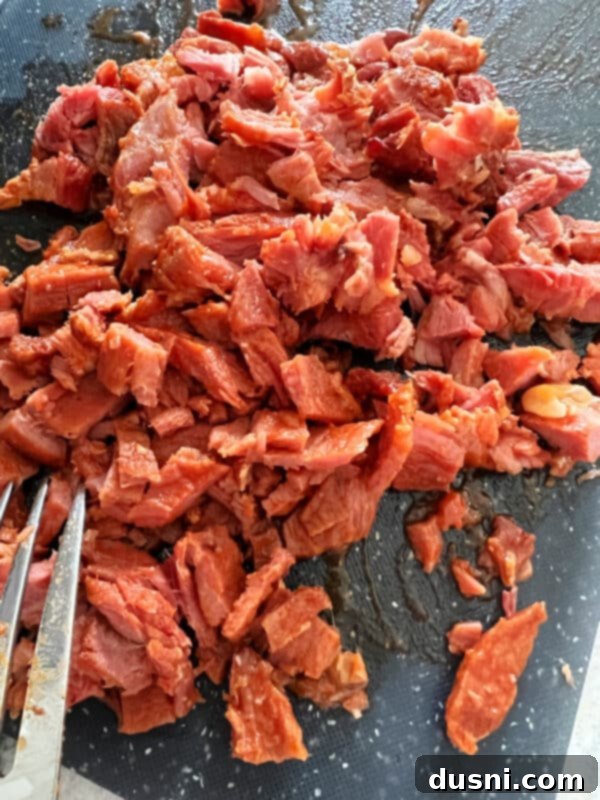
Finally, remove the ham bone from the soup. Any ham that has fallen off can stay in the pot. Carefully pick any remaining tender ham from the bone and chop it into bite-sized pieces. Return the shredded or chopped ham back into the hot soup. Give it a good stir and serve your hearty Instant Pot Ham and Bean Soup immediately, garnished with fresh parsley if desired. Enjoy this comforting and flavorful meal!
Alternative Cooking Methods: Enjoy Ham and Bean Soup Without a Pressure Cooker
While the Instant Pot offers unparalleled speed and convenience, you can absolutely make this delicious ham and bean soup using other traditional cooking methods. Here’s how:
**To make ham and bean soup in the crock pot (slow cooker):** Follow the exact same preparation steps, including the overnight soaking of the lima beans. Once the ingredients are assembled, place them into your slow cooker. Cook on the low setting for 6-8 hours, or until the beans are wonderfully tender and the ham easily falls from the bone. The low and slow cooking method yields a rich, deeply flavored broth.
**To cook the soup on the stovetop:** If you prefer a more traditional approach, you can prepare this soup in a sturdy Dutch oven, a large soup pot, or a large stock pot. Follow the initial prep steps for soaking and rinsing the beans. Combine all the ingredients in your chosen pot, ensuring there’s enough liquid to cover everything (you might need to add a bit more water or chicken broth if using a larger pot). Bring the soup to a gentle simmer, then reduce the heat to low, cover the pot, and let it cook for approximately 90 minutes. Continue cooking until the beans have reached your desired tenderness and the ham effortlessly separates from the bone. Stir occasionally to prevent sticking.
Love This Recipe? Pin it for Later!
If you’ve fallen in love with this comforting ham and bean soup recipe and want to make sure you can easily find it whenever a craving strikes, don’t forget to save it! Pin it to your favorite Pinterest recipe board before you navigate away. This way, you’ll always have this delicious, easy, and family-approved soup at your fingertips, ready to warm your soul on any day.
Did You Know That One-Third of the Pork Raised in the United States Comes from Iowa?
This fact might surprise many of you, but it’s a deeply personal one for me. My husband actually grew up on a farm nestled in rural Iowa. His family farm cultivated corn and soybeans, and importantly, they raised hogs. Beyond farming, his father also owned the local fertilizer and anhydrous business, making him an integral part of the agricultural community.
I vividly recall my first trip to the farm to meet his parents. They couldn’t quite get over the “city girl” he had brought home. Now, if you’re reading this from bustling metropolises like New York City or Los Angeles, you might be thinking, “Omaha? A big city?” But believe me, compared to his hometown of just 300 residents, Omaha felt like a sprawling urban center! I had never seen a hog up close, nor did I even know what a combine harvester was.
In the early days of our marriage and family life, we spent many, many weekends on that farm. Our children grew up with the unique experience of riding in tractors during harvest season, lovingly feeding the farm cats, and learning firsthand what it truly meant when Grandpa would say, “that’s the smell of money.” Those crops and those hogs weren’t just commodities; they were their livelihood, their passion, and the foundation of their family.
This personal connection highlights a vital point: when you purchase pork at your grocery store, whether you’re in Iowa or anywhere else across the United States, you are directly supporting local family farms, not just in Iowa, but in many other parts of the U.S. These are often multi-generational operations, dedicated to bringing quality products to your table.
No matter the size of the farm, big or small, it’s essential to recognize that there is always a dedicated family behind it, diligently doing the hard work, day in and day out, to raise the pork we enjoy. By choosing pork, you’re not just buying a cut of meat; you’re contributing to the sustainability of these cherished agricultural traditions and supporting the families who make them possible.
Frequently Asked Questions About Making Ham & Bean Soup
Here are some common questions and helpful answers to ensure your ham and bean soup turns out perfectly every time.
- What kind of beans do you put in ham soup? For this particular recipe, I’ve used dried lima beans, which contribute a wonderful creamy texture and mild flavor. However, the beauty of ham and bean soup is its versatility! You can easily substitute other white beans such as cannellini beans, white kidney beans, navy beans, or great northern beans. To save yourself an extra trip to the grocery store, I recommend checking your pantry first to see if you have any of these other excellent options on hand. Just be sure to follow the soaking instructions for dried beans, regardless of the variety.
- How do you thicken Ham and Bean Soup? If you find your soup isn’t as thick as you’d like, there are several simple ways to achieve a richer consistency. You can add more cooked beans to the soup, or stir in a tablespoon or two of tomato paste for a double dose of flavor and body. Another effective method is to create a slurry by whisking together a tablespoon of cornstarch or all-purpose flour with an equal amount of cold water, then slowly pouring it into the simmering soup while stirring until it thickens. For a truly creamy and naturally thickened soup, I sometimes use an immersion blender to puree a portion of the beans directly in the pot, or simply mash some of the beans against the side of the pot with a potato masher.
- What to add to beans to make them taste better? To truly elevate the flavor of your beans and the entire soup, consider incorporating fresh herbs. Fresh parsley, stirred in at the end, adds a bright, herbaceous note, while a sprig of rosemary, added during cooking, imparts a lovely earthy aroma. If using dried herbs, a pinch of dried thyme, oregano, or a couple of bay leaves added to the pressure cooker along with the other ingredients will infuse wonderful depth of flavor. A dash of smoked paprika or a hint of cayenne pepper can also add a subtle complexity and warmth.
- What kind of beans do you put in ham and beans? While our specific recipe calls for lima beans due to their classic appeal and creamy texture, the term “ham and beans” is quite broad! Many regions and family traditions use a variety of beans, so feel free to experiment with your personal preference. Navy beans are a popular choice for their ability to break down and thicken the broth, while great northern beans hold their shape well and have a delicate flavor.
- Why are my beans mushy in Instant Pot? If your beans turn out too mushy, it’s most likely due to overcooking. Pressure cookers are efficient, so precise timing is key. Also, be aware that canned beans are generally softer and more prone to getting mushy in a pressure cooker compared to dried beans. If using canned beans, drastically reduce the cooking time or add them closer to the end.
- Do I need to soak beans before cooking in Instant Pot? There’s certainly a debate within the culinary world about whether to soak beans before cooking them in an Instant Pot. Many modern recipes suggest it’s not strictly necessary. However, I was taught by my Mom and my Grandma to always soak my beans, and I continue this practice. They always said, “If it isn’t broken, don’t fix it!” Soaking significantly reduces cooking time, helps with even cooking, and can aid in digestibility, so I always recommend it for this recipe.
- Can you overcook beans in Instant Pot? Absolutely, anything is possible if left too long! While Instant Pots are fantastic, they can indeed overcook beans, turning them into a paste rather than tender legumes. To prevent this with our recipe, stick to the 25-minute cook time and ensure you follow the natural release instructions. Always check for doneness at the specified mark – if they’re not quite tender enough, you can always pressure cook for a few more minutes.
- Do you pressure cook beans on high or low? For dried beans, I consistently suggest cooking them on the high-pressure setting in your Instant Pot. This ensures they cook thoroughly and quickly.
- How long does it take to cook dried beans in a pressure cooker? The cook time for dried beans in a pressure cooker can vary slightly depending on the type of bean and whether they’ve been soaked. Generally, for soaked beans, the cooking time typically ranges between 20 and 30 minutes on high pressure, followed by a natural release. Our recipe for lima beans fits perfectly within this timeframe.
Smart Substitutions to Customize Your Soup
This ham and bean soup recipe is wonderfully adaptable! Feel free to customize it based on what you have on hand or your personal preferences.
**Change up the beans** for a different white bean variety. Cannellini beans, white kidney beans, navy beans, or great northern beans will all work deliciously. Just remember that the cooking time specified in this recipe is based on using pre-soaked, dry lima beans, not canned beans. If using a different type of dried bean, consult a general Instant Pot bean cooking chart for potential slight adjustments to cooking time, though 25 minutes is a good starting point for most soaked white beans.
Instead of tomato juice, you can also experiment with other flavorful liquids. **Clamato juice** offers a unique savory and slightly spicy kick, while **vegetable juice cocktail** will provide a similar vegetable base with added nutrients.
For an extra layer of savory depth, **use chicken broth or chicken stock** in place of the water during the initial bean soaking (if you choose to do a quick soak and cook) or to supplement the tomato juice if you desire a thinner broth. This will add more complexity than plain water.
Expert Tips and Tricks for the Best Ham and Bean Soup
Maximize flavor, convenience, and minimize waste with these helpful tips for your Instant Pot Ham and Bean Soup.
**Keep a smoked ham hock in the freezer** as a clever shortcut. This ensures you can easily make this comforting soup on a whim, as most other ingredients like dried beans, tomato juice, and onions are shelf-stable pantry items. A ham hock provides incredible smoky flavor and tender meat even without a full ham bone.
**Never throw away a leftover ham bone or extra holiday ham!** These precious ingredients are gold for making future meals. Instead, immediately store them in an airtight container or freezer bag in the freezer. The ham bone will infuse your soup with unparalleled depth, and diced leftover ham can be added to countless dishes.
This soup **freezes exceptionally well**, making it perfect for meal prep or busy days. Consider making a double batch and stashing half in the freezer in an airtight, freezer-safe container or individual portions. Freezing homemade food is a fantastic way to ensure you always have a wholesome, delicious meal on hand when life gets hectic and you don’t have time to cook from scratch. To enjoy, simply rewarm the delicious soup gently over medium heat in a saucepan on the stovetop until heated through.
There’s **no need to bring the soup to room temperature** before placing it in the fridge for short-term storage or transferring it to the freezer for longer preservation. Just allow it to cool slightly on the counter (not more than 2 hours) before sealing and storing.
More Delicious Recipes and Ways to Enjoy Pork
No matter the cut or the preparation method, pork holds a frequent and cherished place at our family table. Pork is not only incredibly versatile and flavorful, but it’s also packed with protein and has rightly earned its reputation as a lean, healthy white meat.
For those interested in the nutritional aspects, I encourage you to explore how pork compares nutritionally to other popular meats. You can also find an excellent guide to the leanest cuts of pork and learn how pork producers have continually responded to consumer demands for leaner, healthier pork options. It’s a testament to their commitment to providing delicious and nutritious food.
Here are even more fantastic pork recipes for you to savor and enjoy, showcasing the incredible diversity of this wonderful meat:
- Pork Chops with Mushroom Gravy (as pictured above): Tender pork chops smothered in a rich, savory mushroom gravy – pure comfort food!
- Smoked Pork Loin: A flavorful and juicy pork loin, slow-smoked to perfection, ideal for entertaining or a special family dinner.
- Baked Pork Chops with Stuffing & Mushroom Gravy: An all-in-one comforting meal featuring succulent baked pork chops paired with savory stuffing and a delectable gravy.
- Bacon-Wrapped Pork Ribs: Indulgent and bursting with flavor, these ribs are wrapped in crispy bacon and coated in a sweet and spicy glaze.
- Green Chile Quiche with Sausage: A vibrant and savory quiche featuring spicy green chiles and hearty pork sausage, perfect for brunch or a light meal.
- Breaded Pork Cutlets: Crispy on the outside, tender on the inside, these classic breaded pork cutlets are always a crowd-pleaser.
- Fuggedaboutit Pork Roast: A hassle-free, set-it-and-forget-it pork roast recipe that delivers incredible tenderness and flavor.
- Slow Cooker Glazed Ham: Achieve a perfectly moist and flavorful glazed ham with minimal effort, thanks to your slow cooker.
- Five Bean Ham & Rice Salad: A refreshing and hearty salad, perfect for using up leftover ham in a new and exciting way.
Explore More: Find All My Soup Recipes, Instant Pot Recipes, and Pork Recipes
Be sure to follow along with the amazing team at Iowa Pork on their social media channels, including Instagram, Facebook, Pinterest, and Twitter. They are a fantastic resource for discovering even more delicious pork recipes and valuable cooking tips all year round!
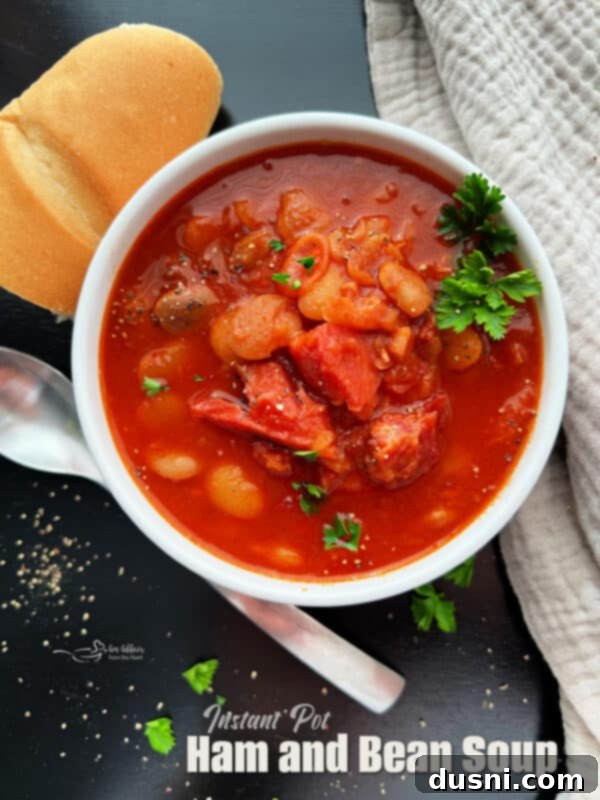
Every single time I prepare this beloved ham and bean soup recipe, it does more than just warm my body; it truly warms my soul. Knowing that I’m continuing a cherished family tradition, I can almost feel Grandma’s joy and approval that her recipe is still being enjoyed decades after she first made it for me. This soup isn’t just food; it’s a legacy of love and comfort. I wholeheartedly encourage you to make it for your own family. Share the warmth, create new memories, and please let me know how much your loved ones enjoy this timeless dish!

LIKE THIS RECIPE?
Don’t forget to give it a ⭐️⭐️⭐️⭐️⭐️ star rating and
leave a comment below the recipe!

Print Recipe
Instant Pot Ham & Bean Soup
Equipment
-
12-Piece Black Sharp Knife Set with Covers, Cutting Board and Sharpener
-
Instant Pot DUO60 6 Qt 7-in-1 Multi-Use Programmable Pressure Cooker
Ingredients
- 1 ham bone with some ham left on it (or use ham hocks/shanks)
- 1 quart tomato juice
- 1/2 cup onion chopped (about half a medium onion)
- 1 16 ounce package Dried Lima Beans
- 2 Tablespoons baking soda (for soaking beans)
- cold water (for soaking beans)
- freshly ground black pepper (to taste)
Instructions
-
**Prepare Beans (Night Before):** Rinse dried lima beans thoroughly and place them in a shallow baking dish or large bowl. Sprinkle with 2 Tablespoons of baking soda and cover completely with cold water. Let them soak overnight (at least 8 hours). Before cooking, discard the soaking water and rinse the beans well under cool, fresh water.
-
**Assemble Soup:** Place the ham bone in the inner pot of your Instant Pot. Add the rinsed, soaked beans (approximately 2/3 of the batch for a brothier soup, or all for a thicker soup), tomato juice, and chopped onion. Season generously with freshly ground black pepper. Do not add salt at this stage, as ham is typically quite salty.
-
**Pressure Cook:** Secure the lid on your Instant Pot and ensure the sealing vent is closed. Set to “Manual” or “Pressure Cook” (High Pressure) for 25 minutes. Once cooking is complete, allow a natural pressure release for 10 minutes, then manually release any remaining pressure before carefully removing the lid.
-
**Serve:** Carefully remove the ham bone from the soup. Any ham that has fallen off can remain in the pot. Pick any remaining ham from the bone and chop it into bite-sized pieces. Return the chopped ham to the soup, stir well, and serve hot. Taste and adjust seasoning if needed, though salt is often unnecessary.
Notes
When my mom prepares this soup, she typically uses about two-thirds of the soaked beans (roughly 3 cups). I’ve adopted this practice as I prefer a soup with a bit more broth, and lima beans do absorb a good amount of liquid. If you enjoy a thicker, heartier soup, feel free to use the entire batch of soaked beans.
A key tip for this recipe is to **never add salt** during the initial cooking phase, as the ham and ham bone naturally impart plenty of savory saltiness to the soup. You can always taste and adjust seasoning at the very end, if necessary.
